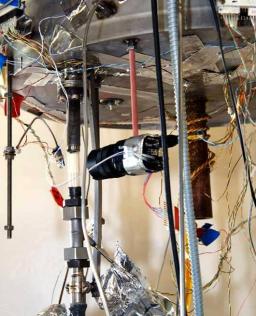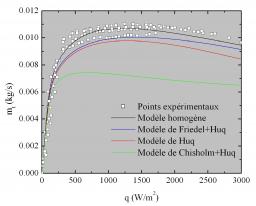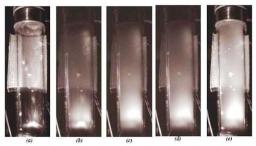This work, which is essentially experimental, is aimed at the study of different parameters in a natural circulation helium loop such as mass flow rates, temperature differences at the wall, pressure variations in the flow, heat transfer coefficients and critical heat fluxes. It is part of the studies of the cooling system of the superconducting magnet in the Compact Muon Solenoid (CMS), the detector that is currently under construction at Cern for the Large Hadron Collider (LHC).
The hydraulic parameters of total mass flow and pressure variation can be modelled using a simple model, the homogeneous model, where the properties such as the density of the two phases are homogenised. The accuracy of the homogeneous model can be explained by the fact that the difference in the physical properties of the two phases is small. The ratio of liquid density to gas density at 4.2 K is only 6, while for water it is 1,000, and that of viscosities is 3. This model has made it possible to validate a numerical simulation predicting the flow rates in the CMS magnet.

Visualisation device. The glass tube is connected to the study tube by gluing to bellows and metal seals. The CCD camera, with a live view, is maintained at 80 K. The lighting system is composed of external systems (halogen and ordinary bulbs) and an internal optical fibre system.
The thermal properties of the flow are also useful for magnet manufacturers, especially the wall heat transfer coefficients. With low heat fluxes, we find a regime dominated by forced convection and, with high heat fluxes, a regime dominated by nucleate boiling. The correlations of different authors have been compared to the experimental results, taking account of the two phenomena, with the help of power laws and weighting coefficients. A correlation developed at the SACM gives greater accuracy and predicts the results to within approximately 15%.
Finally, what we know least about is the flow structure, i.e. the geometrical distribution of the two phases in the flow. The cryogenic environment and the decision to be non-intrusive make the creation of a visualisation system difficult. The visualisation system used is composed of a glass tube stuck onto bellows and a conventional CCD camera. This device has made it possible to provide images of such a flow. The first results are encouraging although problems of blurring have not yet been resolved. The formation of bubbles is clearly visible, but it was difficult to make any conclusions about the flow regime (bubbles, agglomerated bubbles, dispersed air pockets, etc.). Further work is planned to improve the system.



